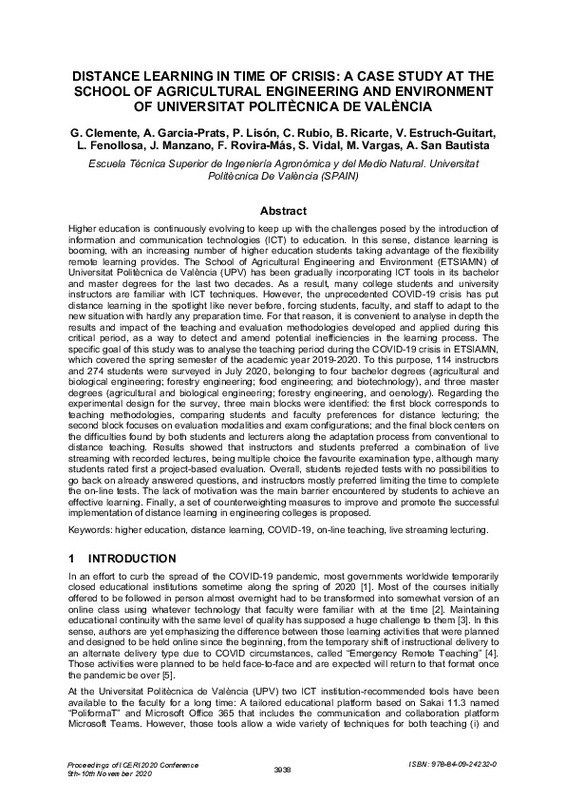|
Resumen:
|
[EN] Higher education is continuously evolving to keep up with the challenges posed by the introduction of
information and communication technologies (ICT) to education. In this sense, distance learning is
booming, with ...[+]
[EN] Higher education is continuously evolving to keep up with the challenges posed by the introduction of
information and communication technologies (ICT) to education. In this sense, distance learning is
booming, with an increasing number of higher education students taking advantage of the flexibility
remote learning provides. The School of Agricultural Engineering and Environment (ETSIAMN) of
Universitat Politècnica de València (UPV) has been gradually incorporating ICT tools in its bachelor
and master degrees for the last two decades. As a result, many college students and university
instructors are familiar with ICT techniques. However, the unprecedented COVID-19 crisis has put
distance learning in the spotlight like never before, forcing students, faculty, and staff to adapt to the
new situation with hardly any preparation time. For that reason, it is convenient to analyse in depth the
results and impact of the teaching and evaluation methodologies developed and applied during this
critical period, as a way to detect and amend potential inefficiencies in the learning process. The
specific goal of this study was to analyse the teaching period during the COVID-19 crisis in ETSIAMN,
which covered the spring semester of the academic year 2019-2020. To this purpose, 114 instructors
and 274 students were surveyed in July 2020, belonging to four bachelor degrees (agricultural and
biological engineering; forestry engineering; food engineering; and biotechnology), and three master
degrees (agricultural and biological engineering; forestry engineering, and oenology). Regarding the
experimental design for the survey, three main blocks were identified: the first block corresponds to
teaching methodologies, comparing students and faculty preferences for distance lecturing; the
second block focuses on evaluation modalities and exam configurations; and the final block centers on
the difficulties found by both students and lecturers along the adaptation process from conventional to
distance teaching. Results showed that instructors and students preferred a combination of live
streaming with recorded lectures, being multiple choice the favourite examination type, although many
students rated first a project-based evaluation. Overall, students rejected tests with no possibilities to
go back on already answered questions, and instructors mostly preferred limiting the time to complete
the on-line tests. The lack of motivation was the main barrier encountered by students to achieve an
effective learning. Finally, a set of counterweighting measures to improve and promote the successful
implementation of distance learning in engineering colleges is proposed.
[-]
|









